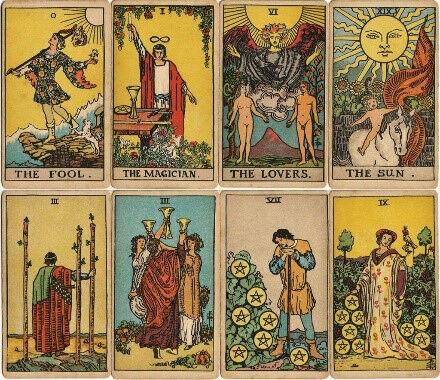 |
"The Tower" card from the Rider-Waite-Smith Tarot deck |
The recent miniseries Agatha All Along features the famous Rider-Waite-Smith Tarot deck, originally published by Rider in 1908, with sublime illustrations by Pamela Colman Smith and instructions by poet-mystic A. E. Waite, both members of the Hermetic Order of the Golden Dawn, a secret society devoted to occultism.
 |
Pamela Colman Smith |
A pivotal scene in one episode of the series employs the Major Arcana card The Tower (pictured above), which per Waite's instructions in the Pictoral Key to the Tarot represents:
"Misery, distress, indigence, adversity, calamity, disgrace, deception, ruin. It is a card in particular of unforeseen catastrophe. Reversed: Negligence, absence, distribution, carelessness, distraction, apathy, nullity, vanity"
Note the emphasis on "unforeseen catastrophe", which is illustrated on the card by the lightning strike that knocks the crown and "wizards" from the tower and sets it afire. Per the Wikipedia page, Smith's design for this card is drawn from the card in the Tarot of Marseilles, which in turn had merged earlier concepts.
 |
Rider-Waite-Smith cards at the Whitney |
I've been a fan of Smith's illustrations since seeing the Rider deck on display in an exhibit of modernist art at the Whitney in NYC, where the Tower card jumped out at me, obviously, given my interest in the Tower of Zenopus. Seeing it again in the Agatha show reminded me of how well it resonates with the backstory of Holmes' sample dungeon, where the wizard and his tower are destroyed by unknown forces and a consuming fire, although here from beneath rather than above:
"Fifty years ago, on a cold wintry night, the wizard's tower was suddenly engulfed in green flame. Several of his human servants escaped the holocaust, saying their master had been destroyed by some powerful force he had unleashed in the depths of the tower"
I'm not suggesting that the Tower Card had any particular influence on Holmes' story, only that it has a similar theme, which also recalls ancient legends like the Tower of Babel or Zeus smiting the legendary doctor Asclepius with a bolt-from-the-blue for advancing his medical knowledge so far that he brought the dead back to life.
Holmes was a doctor and a scientist, but being a life-long fan of pulp and weird fiction, would have been familiar with the occultism as practiced around the turn of the 20th century. For example, he was a member of the Machen Society, devoted to the author Arthur Machen, who was friends with A. E. Waite and even briefly joined the Golden Dawn. In writing his own fantasy, Holmes occasionally employed the trappings of the occult. One Boinger and Zereth story, The Sorcerer's Jewel, features a medium, Misteera, who conducts seances, and another, In the Bag, even has the wizard Murray employ a tarot deck, albeit for solitaire rather than fortune telling; Boinger suggests that he "Play the knave on the Queen of Cups".
However, in crafting the tale of Zenopus, Holmes was more likely directly inspired by the various doomed wizards in the Weird Fiction. In the Holmes Manuscript series, part 46, I went through the introduction to the Sample Dungeon and examined where Holmes may have taken inspiration from the works of H.P. Lovecraft, Clark Ashton Smith and Robert E. Howard.



